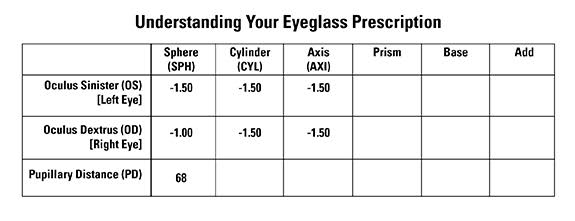Posted by: Georgia Eye Physicians and Surgeons in Latest News
At Georgia Eye Physicians & Surgeons, we want our patients to have a strong understanding of how their eyes and corrective lenses work. While the person who needs to best understand your vision prescription is the optician who makes your glasses, it can still be useful for you to know what the various numbers and terms on your prescription mean. We’ll have to tackle contact-lens prescriptions another day, as they use different measurements and are not interchangeable with eyeglass prescriptions.

The first thing you may notice on your prescription is the presence of some unfamiliar, somewhat dramatic-sounding words. This is because, like much of the terminology we use in the medical field, some of the labels on an eyeglass prescription are in Latin. The original meaning of the Latin word “sinistra” or “sinister” is “left” in English, and “dexter” or “dextrus” is the Latin word for “right.” “Oculus” is Latin for “eye.” Thus, “oculus sinister (OS)” and “oculus dextrus (OD)” simply refer to the patient’s left and right eyes, respectively. You may also occasionally see the phrase “oculus uterque (OU),” which means “both eyes.”
>If you’re only nearsighted or farsighted and don’t have astigmatism, you may only see numbers in the first column of your eyeglass prescription. Sometimes labeled as “Sphere,” “SPH,” or simply “S,” the spherical value in an eyeglass prescription describes the degree of nearsightedness (myopia) or farsightedness (hyperopia) in the patient’s eyes. Measured in units called diopters (specifying focusing power), the patient’s degree of nearsightedness is indicated by a minus symbol (-), whereas his or her degree of farsightedness is signified by a plus symbol (+). The number’s distance from zero signifies the strength of a patient’s prescription or severity of their eye’s nearsightedness or farsightedness. Most people’s prescriptions have either plus or minus signs, but you may see both symbols if you’re nearsighted in one eye and farsighted in the other (though this is fairly rare).
The next column refers to the “Cylinder,” “CYL,” or “C” values in your eyeglass prescription. These values indicate a patient’s level of astigmatism, a vision error that’s caused by a misshapen cornea. Like the numbers in the “Sphere” column, the cylinder values are measured in diopters and preceded by plus or minus symbols. Also like the spherical values, nearsighted astigmatism is indicated by a minus symbol and farsighted astigmatism is signified by a plus symbol. The bigger this number, the more severe the patient’s astigmatism.
The next column, labeled “Axis” or “AXI,” indicates the orientation of a patient’s astigmatism. In patients with astigmatism, the axis value is combined with the cylinder value to determine the lens shape needed to correct this vision error. Measured in degrees and signified by a number between 1 and 180, the axis value tells the optician making your prescription eyeglasses> where your astigmatism (or difference in corneal curvature) is located.
“Pupillary Distance (PD)” tells the optician exactly where your pupil will be located in relation to each lens. If you have one PD number (binocular PD), this is simply the distance (in millimeters) between your pupils. Some patients may have two PD values (monocular PD), each of which measures the distance from the pupil to the bridge of the nose.
The “Prism” and “Base” columns indicate the degree (in diopters) and direction (up or down) of any prismatic power needed in the lenses. These values are relatively rare and only necessary for patients whose eyes have alignment problems. Numbers in the “Add” column are also less common and signify additive power needed for patients whose prescriptions are mainly for distance correction.
If you’re interested in updating your glasses prescription or any of the many services we offer, contact Georgia Eye Physicians & Surgeons to schedule an appointment today. Be sure to follow Dr. William Segal and Dr. Marc Lay on Facebook and Twitter for more eyecare information, fun facts, and the latest news and updates about eye health.

